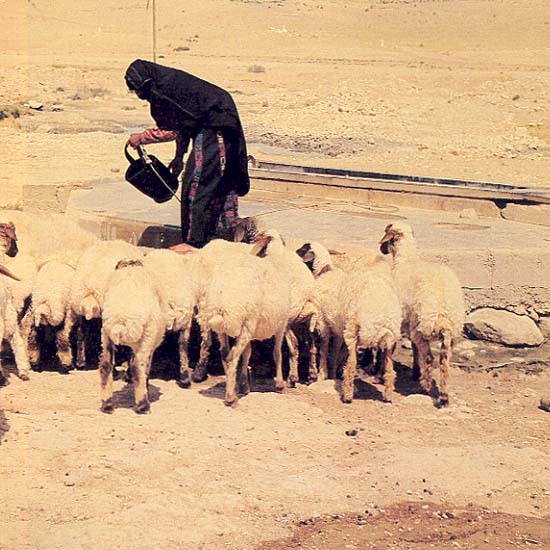
Three sites in the Bible—and perhaps foura—are called Aroer (pronounced Ah-roe-air). We call one Aroer of the Negev. The other two—or three—are east of the Jordan River.
Aroer may mean “crest of a mountain.” This very general description would explain why several sites have this name. Or, Aroer may be derived from the name of the juniper plant, Ar’ar (Juniperus Phoenicia), a common plant in arid zones; this meaning also could give rise to several Aroers.

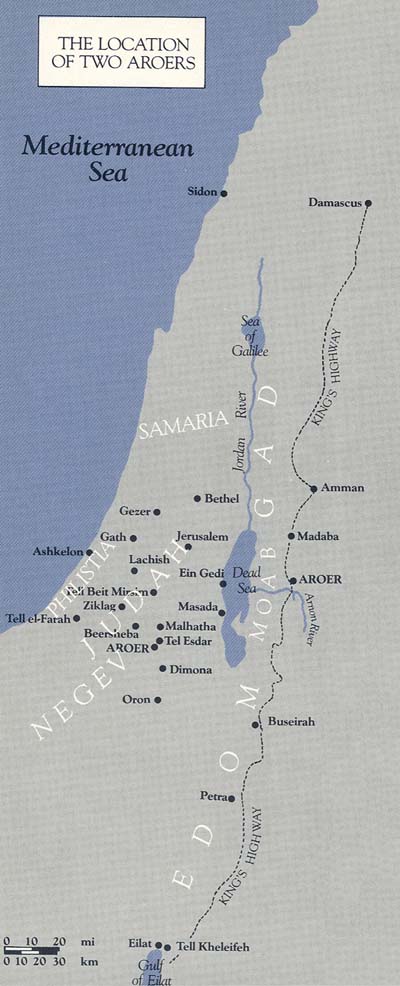
The most frequently mentioned Aroerb is on the bank of the river known in the Bible as the Arnon (the Wadi Mujib). The Arnon was on the ancient route called the King’s Highway on the high plateau east of the Jordan River. This Aroer marked the southern boundary of the Israelite territories in Transjordan and is even mentioned in line 26 of the famous Mesha stone.1 A Spanish archaeological team excavated this Aroer in 1964–65.
The second Biblical Aroerc is located near ancient Amman, located at modern Amman, capital of Jordan. This Aroer was part of the territory of the tribe of Gad. Jephthah, one of the Israelite judges, fought the Ammonites “from Aroer to Minnith” (Judges 11:33). The exact identification of this Aroer is, however, uncertain, and it has never been excavated.
As for the third Aroer, we’re really not sure it is mentioned in the Bible and whether, if it is, it might be the same as the second Aroer. The relevant passage in the Hebrew Bible, Isaiah 17:2, differs from that of the Septuagint, the third to first century B.C. Greek translation of the Hebrew Bible. (There are also differences among modern translations.) The chapter as a whole is a prophecy against Damascus: “Damascus shall cease to be a city; it shall become a heap of ruins.” The Hebrew version continues, “The town of Aroer shall be deserted.” In the Septuagint, the second verse reads, “Its towns shall be deserted forever”—but there is no mention of Aroer. Many modern translations accept the Septuagint version rather than the Hebrew version. But, obviously, this may—or may not—be a reference to a third Aroer, often called the Damascus Aroer. If it is a third Aroer, it may be the one cited in an extra-Biblical text from the eighth century B.C. first published in 1958.2
The fourth Aroer—or the third, depending on how you’re counting—is mentioned only once in the Bible, in 1 Samuel 30:26–31.d This is the Aroer in the Negev of Israel—the Aroer we excavated between 1975 and 1981, and the one on which I would like to report to BAR readers.
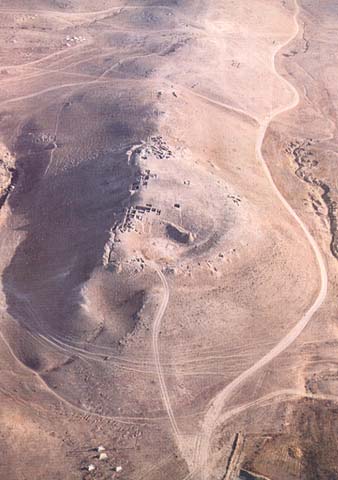
When the future King David—and 600 of his men—fled from the wrath of King Saul and entered the service of the Philistine lord Achish of Gath, Achish granted David Ziklag to live in as his own city (1 Samuel 27). Later, the Amalekites raided and burned Ziklag while David and his men were away (1 Samuel 30). When David returned and found Ziklag destroyed, he pursued the Amalekites and defeated them and took much spoil. Although he was then in the service of the Philistines, David distributed the spoils to the elders of Judah saying, “‘This is a present for you from our spoil of the enemies of the Lord.’ [David sent the spoil to the elders] in Bethel … and … in Aroer.” (1 Samuel 30:26–28).
I never cease to marvel at the revelations of archaeology. How much of our knowledge of history depends on the archaeologist’s spade. The Negev Aroer is surely a case in point. Except for the Biblical reference telling us that there were elders there in David’s time, nothing at all is known of the place. These elders must have been important enough for David to seek their favor and thus win their support in his effort to consolidate the United Monarchy of Israel. But exactly where the Negev Aroer was and what kind of city it was, we are not told.
The Negev Aroer was identified in 1838 by that intrepid American scholar and traveler Edward Robinson, to whom we owe so much in our study of the historical geography of the Holy Land. In the Negev, Robinson found a broad wadie with “many pits for water which are called Ar’arah and give the name to the valley … In the valley and on the western hill are evident traces of an ancient village or town … small fragments of pottery are also everywhere visible. In this instance, the name leaves little room to doubt that this is the site of ancient Aroer of the south of Judah.”3
This identification has now been universally accepted by Bible scholars as well as archaeologists. There can be no doubt that the Arabic names Ar’arah and Bir Ar’air (“wells of Aroer”) represent the modern linguistic descendants of the Aroer of old.
Some of the ancient ways of life persist at this site. The Bedouin still bring their animals to be watered at the ancient wells. Neither the heavy traffic on the modern highway from Beersheba to Dimona nor the occasional train carrying phosphates from Oron disturbs the patriarchal scene—unchanged from time immemorial. As I watched the modern traffic and the patriarchal Bedouin on an early trip to the ruins of Aroer, I thought to myself, “Neither the drivers of camels nor the drivers of the cars, in the pursuit of their daily lives, are aware of the hidden treasures of ancient Aroer that they are passing.”
Rudolph Cohen,4 District Archaeologist of the Israel Department of Antiquities, and I directed the archaeological expedition of Hebrew Union College—Jewish Institute of Religion (HUC-JIR) to Aroer. Our purpose was not, however, to prove or disprove the existence of a city in David’s time. The encroachments of modern civilization were endangering the ancient remains and we were asked to conduct a short emergency excavation that would uncover and preserve as much information as possible in a short period.
A preliminary survey of the site revealed that the remains of ancient occupation covered a relatively large area of over five acres. By comparison, the much more famous Beersheba, which is nearby, covered only two and one half acres.
In 1975, we mounted a brief two-week campaign. The rescue operation revealed remains of large buildings and a jar handle stamped with the letters lmlk (lamelech) meaning “belonging to the king.” We also found a dome-shaped stone weight incised with the sign for four shekels, a small limestone altar, a sherd with the remains of three Hebrew letters, probably representing the word shalosh (three), a fragment of a glass bowl similar to those found in Assyrian palaces, and a stone silo containing a large number of vessels and an Astarte figurine. Further excavations were clearly in order. So each year until 1981, we returned to the site for additional excavation.f

I must tell you at the outset that we found no evidence for David’s Aroer, a subject I will return to later. Instead, we learned that the Negev Aroer was occupied principally during two periods: at the end of the First Temple period, in the seventh to early sixth centuries B.C., and at the end of the Second Temple period, from the first century B.C. to the first century A.D. (the Herodian period). During both these periods, Aroer served as a fortified outpost. In the Israelite period, Aroer was larger and more important than in the Herodian.
Aroer is situated on top of a natural knoll about 1300 feet above sea level. On three sides, it is surrounded by wadis, a geographic feature that provides the town with a natural defense. But the original builders of the town were not satisfied with that alone. On the crest of this barren hill, 150 feet above the plain below, they constructed a solid stone inset-offset wall, plastered on the outside. For good measure, they added a steep rampart of earth, rubble and stone which covered the wall’s flat stone facing. The 400 feet of wall we uncovered on the eastern side of the town consists of five offsets 12 feet wide (ranging in length from 37 feet to 45 feet), and four insets 6 feet to 7 feet wide (ranging in length from 42 feet to 50 feet). This wall enclosed an area of 2.5 acres, but people also lived on another 2.5 acres outside the wall.
We excavated a number of rooms built against the inner face of the wall. To overcome the steep natural slope of the hill and to obtain a horizontal level for the floors, the builders had first laid a layer of pebbles. This was a sensible solution to a difficult topographical problem. Once a fairly livable surface was created, a layer of ash and a floor of beaten earth was added.
This was the first settlement at Aroer, what we called stratum III—the third level down from the top. We reached this level in some places in our first two-week excavation. At that time we also found the stone silo to which I referred earlier. It was built on bedrock. The assemblage of finds it contained was obviously of the same period as our stratum III residential structures. If we could date this assemblage, we could date the founding of Aroer.

Some of the vessels from the silo were similar to vessels found in the destruction level of the city of Lachish, destroyed by Sennacherib in 701 B.C. (Lachish III). However, on the basis of other comparisons, a number of our vessels were clearly datable to the seventh century B.C., and not earlier. Obviously, despite the devastation of this part of Judah by Sennacherib’s Assyrian army in 701 B.C., the population had not been totally annihilated. Potters and other artisans continued to practice their trade, as this pottery demonstrated. Moreover, pottery forms and textures of the eighth century did not disappear. Instead they continued to be used even though new forms and new vessels were also introduced.
The date of our pottery assemblage from the silo must be determined not by the earlier eighth century vessels but by the new vessels that appeared only in the seventh century B.C. In subsequent seasons we found more vessels from the seventh century B.C. in rooms built on virgin soil, both inside and outside the town wall. The conclusion is clear—Aroer was first settled in the seventh century B.C. after Sennacherib destroyed the surrounding area at the end of the eighth century (701 B.C.).
This is not as radical a conclusion as it may seem. Archaeological surveys and excavations in the Judean mountains and hills and in the Negev have recently revealed intensive settlement in the seventh century B.C. This unprecedented increase in settlements in the southern kingdom of Judah may have been the result of a population influx from Samaria following the Assyrian conquest of the northern kingdom of Israel in 721 B.C.
Who built Aroer? We can propose two candidates. One is King Manasseh, who ruled for 55 years in the seventh century, the longest reign of any king of Judah. In that century, after Sennacherib’s campaign, Judah was vassal to Assyria. But perhaps Manasseh took advantage of the unsettled conditions in the Assyrian Empire that preceded and followed the Babylonian revolt to strengthen the boundaries of his Judean kingdom. Perhaps Manasseh built Aroer as a bulwark against attack from the south. Although the Bible does not speak well of Manasseh, he must nevertheless be given credit for fortifying Jerusalem and for putting “military commanders in all the walled cities of Judah” (2 Chronicles 33:14). Perhaps Aroer was one of these walled cities.
Another possibility must also be considered. Aroer may have been built by King Hezekiah, who reigned during Sennacherib’s campaign. Sennacherib besieged Jerusalem, but was unable to take the city. According to the Bible, after the Lord slew 185,000 Assyrian soldiers in a single night (2 Kings 19:35), Sennacherib withdrew and Jerusalem was saved. The respite given Hezekiah after Sennacherib withdrew from Jerusalem may have prompted the Judean king to fortify his southern border, including the building of Aroer. In that case, Aroer would already have been a walled city when Manasseh became king. The Biblical reference to Manasseh placing military commanders in all the walled cities of Judah would then mean that he placed a military commander in Aroer, but he did not build it.
We do not know how long the first settlement at Aroer lasted. But the fact that no gap exists between the earliest stratum, Aroer III, and Aroer II suggests that this first settlement was not completely destroyed. The walls of Aroer III houses continued in use in Aroer II, with additions and repairs. Although a thin layer of ash separates the two strata, this layer is far different from the thick ash layer that represents the total destruction of Lachish III. The thin ash layer at Aroer suggests that the destruction was the result of local skirmishes and attacks in the seventh to sixth centuries B.C. In any event, Aroer was soon rebuilt after the misfortunes that befell stratum III.
Stratum II at Aroer represents a large and prosperous community. Whether the original city wall continued to serve as the main defense has not been determined. The date of Aroer II can easily be determined. The pottery repertoire is similar to that found at Ein Gedi, Lachish II, Tell Beit Mirsim, Jerusalem and many other sites, dating to the end of the Iron Age, the late seventh to early sixth centuries B.C. No doubt Aroer was destroyed, along with these other cities and hamlets of Judah, when Nebuchadnezzar, king of Babylon, conquered Judah and destroyed Jerusalem in 587–6 B.C.
Aroer II probably existed for about 30 or 40 years. Perhaps it was built by King Josiah who introduced the religious reformation associated with the composition of Deuteronomy.
Despite the fact that Aroer lasted only about 30 to 40 years, it included three to five phases of occupation. It is as though houses had been destroyed and rebuilt, floor levels raised, walls reused, and household installations built one on top of the other—all within one generation.
This must have been a period of great prosperity. In addition to the evidence of continual building and rebuilding, we found a large assemblage of fine pottery. Even more important were the finds pointing to strong cultural and commercial ties with the maritime coast to the west and with the land of Edom across the Jordan River in the east. This should come as no surprise, because Aroer was located on an important Negev trade route. Decorated “Edomite” sherds of fine texture, similar to those found in Buseirah (Biblical Bozrah) in Edom, were uncovered in almost all excavation areas. A cone-shaped jasper seal is further evidence for an Edomite connection. It was pierced horizontally to be worn on a string. The seal was inscribed lqosa, belonging to Qosa. Qos was an Edomite deity. The owner of this seal thus had a name that included the name of an Edomite deity. Names with the component Qos are known from Assyrian records. Qosgabr, for example, was a king of Edom in the seventh century; the name Qosanal was found on seal impressions on seventh century jars at Tell Kheleifeh near Eilat.
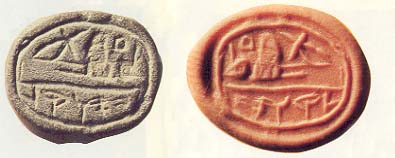
We believe that Aroer was the main administrative center in the southern part of Judah, just before the Babylonian conquest. Edom was Judah’s neighbor on the east. When they were not fighting each other, Edom and Judah must have had extensive commercial and cultural ties.
Aroer’s cultural affinities also extended westward to the Mediterranean coast, as evidenced by the Assyrian Palace Ware vessels we found. We also found a finely polished bone plaque, two inches by one inch, that may have come from the coast and was perhaps influenced by Phoenician culture. We think this plaque may be a calendar. There are three rows of ten holes each (30 days?) and a fourth row with 12 holes (12 months?). Other similar rectangular bone objects with holes have been found at other sites such as Gezer, Lachish and Tell el-Farah (south), but they have only three rows of ten holes each. Ours has four rows with a total of 42 holes. Perhaps a moveable peg was inserted in each hole or groove to mark the days of the month. Our plaque is also unique because the top is in the shape of a proto-Aeolian capital with three additional holes. If our suggestion that this is a calendar is correct, the three top holes may denote some division of the year.

The inhabitants of Aroer must have had a special affection for the goddess of fecundity. Five intact Astarte figurines and fragments of others were found in various areas of the excavations. We also found three small household incense altars; whether they are related to the Astarte cult we cannot say.

But what of the Aroer from David’s time, referred to in the first book of Samuel? If the Aroer to which David sent part of the spoils of his war with the Amalekites has not been found in our excavations, where is it? Although we reached virgin soil in all excavated areas and found no evidence whatever for an 11th to 10th century B.C. settlement, it is always possible that somewhere on this five-acre site, early remains may yet be found. However, this is unlikely. A better theory is that the location of Davidic Aroer is at a site called Tel Esdar, about a mile and a half north of Aroer. Tel Esdar was excavated in 1963–64 when the railway to Dimona threatened it. The expedition uncovered remains from the 11th to 10th centuries B.C., indicating that the town was of some importance in the Davidic period. Tel Esdar was abandoned in the 10th century B.C., possibly because it had been built on the plain and was therefore indefensible. Perhaps the name Aroer did not disappear, and when, in the seventh century B.C., a fortified city was built in a more defensible location on a knoll nearby, the old name was given to the new site. The transfer of a name from one location to another was a well-known practice in antiquity and may explain the absence of 11th to 10th century remains precisely at the Aroer we excavated.
What happened to our Aroer after the destruction of stratum II is also unclear. Apparently, the site was unoccupied for about 500 years following the Babylonian destruction of the last Israelite settlement of stratum II.g Then a new town was built on the hill.
This new town had a large central courtyard (150 feet by 110 feet) and a fortress on the southeast corner of the mound. Commanding the site as well as the entire area below it to the south, this fortress is an impressive structure, built of large limestone blocks beautifully worked in the center-boss style associated with the Herodian period. The fortress is almost square (38 feet by 35 feet). Some of its walls are preserved to a height of six courses (eight feet) above the stone paved floor of the ground level, which was divided into four inter-connecting rooms by two intersecting internal walls.

The original height of the fortress is unknown. All inner and outer walls are of uniform width, four feet, and their inner openings are uniformly narrow, two and one half feet, and eight feet high, giving a firm structural potential for a much greater height and additional upper floors. It is safe to assume that the fortress was at least two stories high. A section about three feet deep in the northwestern corner revealed that the floor was built on a stone fill, which may represent an earlier Iron Age fortress.
The fortress building was itself part of a larger courtyard/garrison complex located on the inner face of the old Israelite city wall. In houses and rooms of the Herodian period along the courtyard wall, we found a destruction level containing charred remains of wooden beams, a bronze mirror, a bronze bell, a juglet, oil lamps, glass fragments, Nabatean sherds, and a coin of the Procurator Antonius Felix from the year 59 A.D.
South of the courtyard wall, we excavated two Herodian rooms in which we uncovered storage jars, measuring cups, oil lamps and glass fragments. One of the glass fragments is of a type known as a “Sidonian” glass cup. Three Greek leters, “AXA,” can be seen on it; they are part of the word [KAT] AXA [IRE], meaning jubilation. Thus the cup was probably used for celebrations or for blessings.
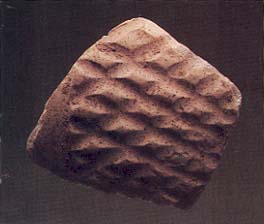
Apparently there was only one access to the fortress. This principle of limited and guarded access was emphasized by the fact that a plastered stone girdle six to seven feet wide was built against all four walls of the fortress. On the courtyard corner, at the fortress entrance, the fortress wall was also reinforced on the inside.
We are not sure who built this fortress and the associated settlement. Most likely they were built by Herod the Great in the second half of the first century B.C. during his extensive building activities, especially at Masada. However, no Herodian coins have been found at Aroer. Another, less likely, possibility is Herod Agrippa (41–44 A.D.). The fact that we found coins minted by Agrippa supports this possibility (We also found other coins from about the same period; one minted in Ashkelon in about 40 A.D. depicts the Roman Emperor Caligula). Josephus, who wrote extensively about the hisory of the land in the last decades before the Roman destruction of the Temple in 70 A.D., says that Agrippa owned a pyrgos, or stronghold at Malhatha, which is identified with Tel Malhata about seven miles north of Aroer. Agrippa’s domain probably extended as far as Aroer, so he could have built a fortress here—or enlarged and strengthened an existing one.

The fortress may have been strengthened again just before the first Jewish revolt against Rome (66–70 A.D.). Because of its wells, Aroer may have served as the Negev headquarters of the Jewish revolutionary commander Simon Bar Giora. Among the finds were two coins from the second year of the Jewish revolt. On the obverse of the coins is an amphora framed with a Hebrew inscription, Shnat shtayim (year two). On the reverse is a leaf from a grapevine and another Hebrew inscription leherut zion (for the freedom of Zion). These coins and the mass of fallen stones provide the archaeological evidence for the Roman destruction of Aroer about the year 10 A.D., in the course of the suppression of the Jewish revolt.
MLA Citation
Footnotes
Joshua 12:2; Joshua 13:9, Joshua 13:16; Deuteronomy 2:36; Deuteronomy 3:12; Deuteronomy 4:48; 2 Kings 10:33; Jeremiah 48:19; Judges 11:26; 1 Chronicles 5:8.
It may however be referred to in Joshua 15:12 as Adadah, which the Septuagint renders as “Aruel.”
A wadi (Arabic) or nahal (Hebrew) is a dry river bed or small river common in Israel and the neighboring regions. During the rainy season, a wadi or nahal may become a raging torrent for a few hours, or even days, or it can be a relatively calm stream.
American students at HUC-JIR and Israeli volunteers formed the enthusiastic labor force. In 1978, students from Wooster College, Ohio, under the direction of Dr. and Mrs. J. Arthur Baird, were welcome workers. In 1980, students from Lewis and Clark College, Portland, Oregon, under the direction of Dr. and Mrs. Richard L. Rohrbaugh, joined us. And in 1981, students from the University of Wisconsin, under the direction of Professor Keith N. Schoville, and from the Southeastern Baptist Theological Seminary, under the direction of Dr. and Mrs. B. Elmo Scoggin, were part of our excavation team.
Endnotes
See Dan Cole’s review of Digging for God and Country, by Neil Asher Silberman (Books in Brief, BAR 08:04).
See A. Dupont-Sommer, Les Inscriptions Araméennes de Sfiré (Paris 1958), and B. Mazar, “The Aramean Empire and its Relations with Israel,” Biblical Archeologist Vol. 25, (1962), p. 118.
Rudolph Cohen is familiar to BAR readers as the author of “Did I Excavate Kadesh-Barnea?” BAR 07:03, and “The Marvelous Mosaics of Kissufim,” BAR 06:01.



